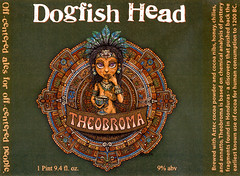The famous Swedish botanist, Linnaeus, is the one who gave the tree and its fruit it wondrous name Theobroma cacao in Latin, Theobroma meaning “food of the gods.” When the fruit has a warty skin, this marks it as belonging to the very delicious and aromatic criollo variety from Mesoamerica. Juicy pulp surrounding 30 to 40 almond-shaped seeds or “beans” fills each pod. It is this sweet pulp, with as much as 15% sugar, that we think first attracted our ancestors to the plant and eventually led to its domestication. Fermentation of ripe fruit occurs naturally, and produces a 5 to 7% alcoholic beverage. In fact, this is the way that the beans are freed from the pod in modern chocolate production. The Spanish chroniclers observed that native peoples along the Pacific coast of Guatemala delighted in a mildly alcoholic beverage, which they made by piling cacao fruit into their dugout canoes and letting it ferment there.
We, and by we I’m also including fellow-scientist Jeff Hurst at Hershey Chocolate, analyzed pottery sherds belonging to long-necked jars. Such vessels from Honduras are among some of the earliest pottery yet found anywhere in Mesoamerica, dating back to around 1400 B.C. They preceded the first urban communities of the Olmecs, centered on the Gulf Coast of what are now Mexico’s Veracruz and Tabasco provinces.
Vessels of the long-necked jar type from Puerto Escondido tested positive for theobromine, which is the fingerprint compound for cacao since the compound only occurs in chocolate fruit and beans in Mesoamerica. The style of the vessel was another give-away or advertisement of its contents–it had the shape and characteristic ridges and indentations of the cacao fruit. What we propose, based on the chemical and archaeological evidence, is that the jar was once filled with a fermented chocolate beverage made from ripe chocolate fruit.
In later Mesoamerica, the Mayans and then the Aztecs increasingly turned to the beans, rather than the fruit, to make their cacao beverage. They also mixed in lots of additives–honey, chilis of all kinds, variously scented flowers, and achiote or annatto (Bixa orellana) which colors the beverage an intense red in keeping with its association with human sacrifice. If a victim atop one of the pyramids faltered, he was given a gourd of chocolate, mixed with blood which had been caked on the obsidian blades of earlier sacrifices.
This later drink was often frothed to give a high head of foam, which can be seen on Mayan frescoes. The idea was apparently to inhale the foam at the same time that one drank the liquid directly from the mouth of the vessel.
When we analyzed the Puerto Escondido jars and bowls, we made a special attempt to identify any of the later additives. None were present, providing a stronger case that the earliest beverage, made only from the fruit, paved the way for the foamy Mayan-Aztec drink made from the beans.
Like grape wine, rice wine, and barley beer in the Old World, chocolate “wine” went on to become the prerogative of royalty and the elite generally, and a focus of religion in the New World. Cacao beans also served as money for the Aztecs, and King Montezuma had a veritable Fort Knox in his storerooms at Tenochtitlan–nearly a billion beans, according to one Spanish informant.
Many of the most stunning pottery vessels from Mesoamerica were made to hold the beverage, like the beautifully decorated and unique jar from a tomb (Rio Azul) in Guatemala, dated to around 500 A.D. It actually has a swivelling, lock-on lid, to protect and selectively dole out its precious liquid. Jeff Hurst confirmed that the liquid was a chocolate beverage. The Mayan hieroglyph for ka-ka-w (“cacao”) was written on the vessel; it shows the head of a fish and a fin, both pronounced ka–hence, ka-ka-w.
If a fermented chocolate beverage was good enough for Montezuma to drink in the 16th c.–he reputedly was served 50 great jars of it at a banquet with 300 dishes–and long before that at Puerto Escondido, then why not try and re-create a modern version of the ancient beverage? Just like we had done before, we enlisted the aid of Dogfish Head Brewery.
Since it proved impossible to transport the fresh fruit without spoilage from Honduras, we did the next best thing. We were able to obtain chocolate nibs and powder from the premier area of Aztec chocolate production, Soconusco, the first such dark chocolate to be imported into the States in centuries (Askinosie Chocolate in Missouri). As you drink this luscious beverage–almost like a fine Scotch or Port–you will pick up the aroma of the cacao and hints of the ancho chili in the aftertaste. Any bitterness of the chocolate is offset by the honey and corn. Achiote colors it red. It was fermented with an American ale yeast.
Of course, we named the chocolate beverage Theobroma, since it is truly an elixir of the gods–as suggested by the image on its label of ab Aztec maiden set among the gods of the four quarters of the universe.


